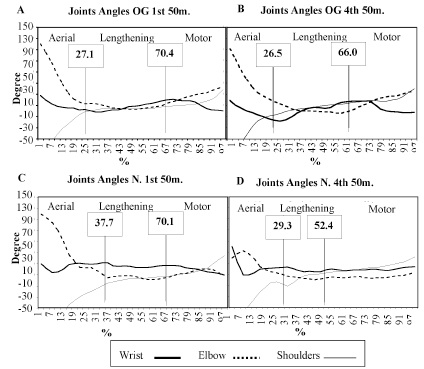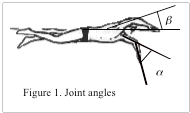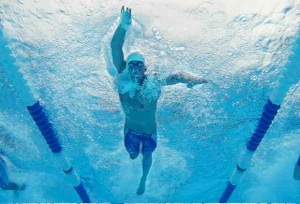The IXth International World Symposium on Biomechanics and Medecine in Swimming in Saint-Etienne in France 2002


Comparison of Front Crawl Arm Lengthening Between Olympic Games Finalists and French National Level Swimmers
Frédéric DUCLOS 1,2, Pierre LEGRENEUR 1, Karine M. MONTEIL 1
1 C.R.I.S. Université Claude Bernard,2 CREPS
Lyon 1, FranceMâcon, France
Abstract
Comparison of arm lengthening during the front crawl stroke in Olympic-level and national-level swimmers demonstrated a functional difference apparently contributing to the difference in performance. During the motor phase of the stroke, the simultaneous displacement of the upper limb segments [Maglischo et al. (1987)] observed in national-level swimmers was replaced by a disto-proximal sequence in the Olympic-level swimmers implying a specific musculo-skeletal coordination of the upper limb. This specific type of coordination would optimise mechanical efficiency by enabling the swimmer to accelerate the catch phase, allowing more time for the generation of propulsive forces.
Key words: arm lengthening, inter-segmental co-ordination, front crawl stroke, performance level
Introduction
Swimming is one of the ways that humans use to move in an aquatic environment [Hellard (1998)]. The front crawl, a particularly popular stroke due the velocity achieved, enables swimmers to produce locomotion by cyclic transfer of the linear and angular momentum of their limbs to the fluid [Vaday et al. (1971)]. This requires muscular activation which implies a peripheral fatigue limiting performance. In order to reduce the muscular force involvement, and thus energy cost, propulsive actions have to be produced with optimal mechanical efficiency [Chartard et al. (1991)]. Optimal mechanical efficiency is defined as the best compromise between energy expenditure and the encountered resistance, or as the best ratio between the power produced and the power required to overcome resistance. The swimmer strives to produce a stroke with optimal efficiency to overcome resistances and create propulsive forces [Rackham (1975)].
Lengthening of the arm in the front crawl stroke appears to be a specific phase of upper limb motion. Arm lengthening corresponds to the first stage of the catch phase, aimed to improve the quality of the next sculling movement [Maglischo et al. (1987)]. Moreover, it could help the swimmer to overcome and reduce resistance by achieving better penetration in the water [Clarys et al. (1975)].
Usually, the front crawl arm stroke can be divided into two phases, aerial and aquatic. Arm lengthening takes place at the transition between these two phases and, as a result, between two different media making it quite difficult to develop an appropriate methodology for study. To our knowledge, little or no work focusing specifically on the lengthening phase has been reported despite the fact that swimmers consider this particular phase to be crucial for achieving an efficient upper limb stroke. Consequently, the aim of this study is to analyse upper limb motion during the arm lengthening phase of front crawl by comparing two categories of high-level competition swimmers.
Methods
The study population was composed of seven male 200 m freestyle swimmers. Four of them were Olympic finalists at Sydney and three competed in the French national-level championships.
Table 1. Characteristics of the study population. The 200m freestyle performance presented was accomplished during the Sydney Olympic Games or during a swimming test.
Swimmer Age (yrs) Height (m) Weight (kg) 200m freestyle performance (m.s-1)
SL 23 1.78 76 1.74
SDB 22 1.90 90 1.74
AC 21 1.79 69 1.72
IT 18 1.95 96 1.90
PVDH 22 1.93 79 1.90
JD 28 1.90 84 1.87
MR 22 1.92 82 1.87
Average 22.3 1.88 82.29 1.82
Sdt D 2.8 0.06 8.26 0.08
Each swimmer swam 200m freestyle at maximal velocity. During the event, he was filmed on a sagittal plan during the first and the last 50m of the swimming distance in order to observe the evolution of the lengthening phase. Video sequences were obtained from television pictures of the Sydney Olympic Games (Olympic-level swimmers) or using a protocol simulating a competition event in a 50m pool (French national-level swimmers). The protocol was designed to mimic the conditions at the Sydney Olympic Games. Video images were recorded with two Sony camcorders (acquisition frequency: 25 Hz) located in the middle of the swimming pool. The camcorders were placed 1m above and 0.40m below the water surface to enable simultaneous acquisition of the aerial and aquatic phases of the upper limb stroke. The camcorders were positioned 7m from the line of the swimmer’s progression so two entire strokes could be recorded. Recorded images were digitised with a specific home-made software [Digit2D, Legreneur (2001)].
The Observation Phase (OP) started when the arm made a 90° angle with the water surface and ended with a –45° arm angle under the water surface. Therefore, this phase lasted from the preparation of the hand entry into the water to the end of the first sweep as described by Maglischo et al. (1987).
The OP was split into three phases: the Aerial Phase (OPa), from the start of the Observation Phase until the hand entry into the water; the Lengthening Phase (OPl), starting at the end of the OPa and continuing to the instant when the horizontal velocity of the hand became lower than the horizontal velocity of the swimmer's head; and the remainder of the Observation Phase, the motor phase (OPm).
The angular positions of the wrist, elbow and shoulder were collected from each frame of the OP recording. Maximal extension for the wrist and elbow joints was taken as zero, with flexion producing a positive angle (Fig. 1 values). The position of the shoulder joint was defined as the segmental angle formed by the arm with the horizontal axis (Fig. 1 values). This angle is positive during the aquatic phase of the front crawl stroke and negative during the aerial phase.
Results
For Olympic-level swimmers, the relative duration of each phase of the OP exhibited a similar temporal pattern in the first and last 50m (Fig. 2A) of the 200m event (Fig. 2B). The time devoted to each phase, OPa, OPl, and OPm was 27.1%, 43.3% and 29.6% during the first 50m and 26.5%, 39.5% and 34% during the last 50m respectively. The French national-level swimmers spent more time in the OPa (37.7%) of the first 50m (Fig. 2C) than the Olympic-level swimmers, shortening the OPl (32.4%). The relative duration of OPm was approximately equivalent for the Olympic- and French national-level swimmers (29.9%). At the end of the event (Fig. 2D), the French national-level swimmers shortened their OPl (23.1%), spending more time in OPm (47.6%) than at the beginning of the event.
The angle measurements showed that the Olympic-level swimmers exhibited a segmental dissociation of upper limb movement during OPm, at the beginning (Fig. 2A) and at the end (Fig. 2B) of the event. During this phase, three successive flexion movements of the upper limb could be distinguished. The first movement was a flexion of the wrist, followed by flexion of the elbow, then the shoulder. This distal-to-proximal flexion pattern was not observed in the French national-level swimmers who maintained their upper limb joints in extension all through the OPm, both during the first (Fig. 2C) and last 50m (Fig.2D).
The motor phase (OPm) thus showed a characteristic difference between the Olympic-level and French national-level swimmers. Wrist and elbow movements were more pronounced in the Olympic-level swimmers, especially at the end of the event. The angular variations of the wrist and elbow during the first 50m were 20.52 and 28.94 degrees respectively for the Olympic-level swimmers and 20.02 and 17.37 degrees for the French national-level swimmers. During the last 50m, the wrist and elbow anglular variations were 21.4 and 38.67 degrees for the Olympic level swimmers and 3.03 and 2.17 degrees for the French national-level swimmers.
Fig. 2. Angular positions of the wrist, elbow and shoulder joints, during the first 50m. (A and C) and during the last 50m. (B and D), for the Olympic-level swimmers (A and B) and the French national-level swimmers (C and D).
Discussion
For the Olympic-level swimmers, the hand was the first segment to move, followed by the forearm and then the arm. This motion seemed to correspond to a disto-proximal coordination of these joints, contrasting with the proximo-distal coordination reported in vertical jumping [Maarten et al. (1988)] and in overarm throw in handball players [Joris et al. (1985)]. In proximo-distal coordination, the characteristic feature is the transfer of a force generated by the mono-articular muscles towards the distal extremity of the segment via the bi-articular muscles [Grégoire et al. (1984)]. This functional mechanism would not appear to be operating in the disto-proximal coordination observed at the beginning of the aquatic path of the upper limb during the front crawl stroke since it would imply transferring force from the more distal segment, the hand, to the more proximal segment, the trunk, and consequently dissipation of the force within the body.
It can therefore be hypothesised that the observed disto-proximal coordination would correspond to an optimal position of the hand in the water during the aquatic phase. This optimal hand position would enable acceleration of the catch phase giving the swimmer more time to apply propulsive force against the aquatic medium. Moreover, the angular position of each joint could permit the muscles to contract at their optimal length, optimising generation of muscular force [Yamaguchi et al. (1990)].
The joint angles measured in the Olympic-level swimmers during the observation phase did not appear to change during the last 50 m. Unlike the French national-level swimmers who exhibited erratic coordination of their upper limbs during the last 50m, probably because of exhaustion, the Olympic-level swimmers were able to maintain control of their intersegmental coordination. These results suggest that induction of pliometric contractions would require an optimal duration of the arm lengthening phase.
In conclusion, the simultaneous action of the upper limb segments, as described by Maglischo et al. (1987) and as performed by the French national-level swimmers appeared to be replaced by a sequential disto-proximal action in the Olympic-level swimmers. This specific type of coordination would enable the swimmer to accelerate the catch phase, allowing more time for the generation of propulsive forces.
References
Chatard J.C, Lavoie J.M., Lacour J.R (1991) Energy cost of front crawl swimming in women. Eur J Appl Physiol ;63(1), p.12-6.
Chatard J.C, Agel A.M., Lacoste L., Millet C., Paulin M. Lacour,J.R. (1991) Coût énergétique du crawl chez les nageurs de compétition. Science et Sport n 6, p. 43-50.
Clarys J.P., Cabri J. (1993) Electromyographiy and the study of sports movements: A review. Journal of Sports Sciences, 11, p. 379-448.
Gregoire L., Veeger P.A., Huijing P.A., Van Ingen Schenau G.J. (1984) Role of Mono and Biarticular Muscles in Explosive Movements. Int. J. Sports Med., 5, p. 301-305.
Hellard (1998), L’entraînement III, p. 13-19, ed. Atlantica (Biarritz) France.
Jacobs R., Van Ingen Schenau G.J., (1992) Intermuscular coordination in a sprint push-off. J. Biomecanics, vol. 25, n° 9, p. 953 – 965.
Joris H.J.J., Van Muyen A.J.E., Van Ingen Schenau G.J., Kemper H.C.G. (1985) Force, velocity and energy flow during the overarm throw in female handball players. J. Biomechanics, vol. 18, n° 6, p. 409-414.
Maglischo E.W. (1987),Nager plus vite, p. 243-255, Collection “Métier de l'eau” (Morzine) France.
Maarten F., Bobbert M.F., Van Ingen Schenau G.J. (1988) Coordination in vertical jump. J. Biomechanics, vol. 21, n° 3, p. 249-262.
Rackham G.W. (1975) Analysis of arm propulsion in swimming. Swimming II, vol. 2, p. 174-179, Lewillie and Clarys, eds., Baltimore: University Park Press.
Vaday M., Nemessuri M. (1971) Motor pattern of freestyle swimming. Biomechanics of Swimming, p. 167-173, Lewillie and Clarys eds., Brussels : Université Libre de Bruxelles.
Van Ingen Schenau, G.J., Bobbert, M.F., Rozendal, R.H. (1987) The unique action of bi-articular muscles in complex movements. J. Anat., 155 p. 1-5.
Yamaguchi G.T., Sawa A.G.U., Moran D.W., Fessler M.J. and Winters J.M. (1990) A survey of human musculotendon actuator parameters. In Multiple Muscle Systems. Biomechanical and Movement Organisation edited by J.M. Winters and S.L.-Y. Woo, pp 717-772, Springer, New York










